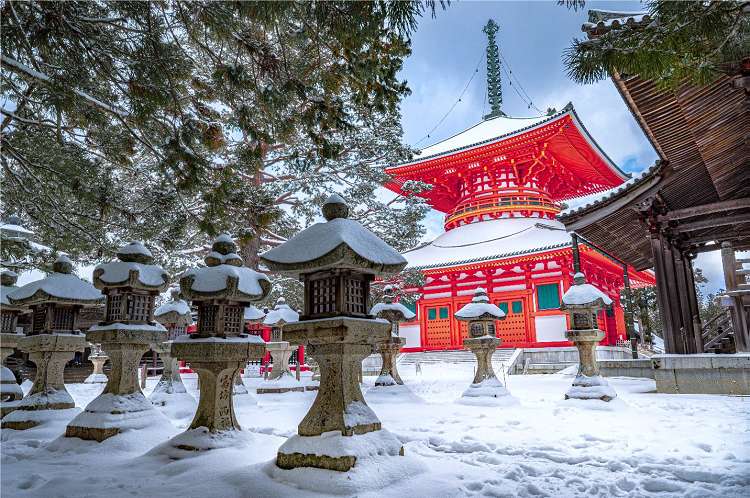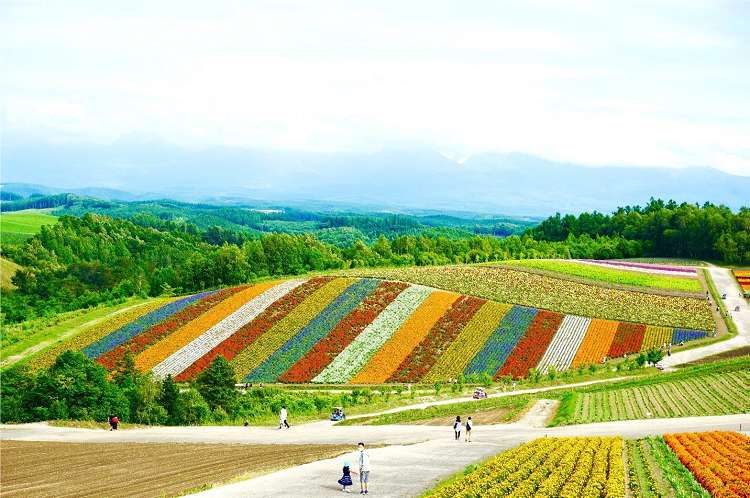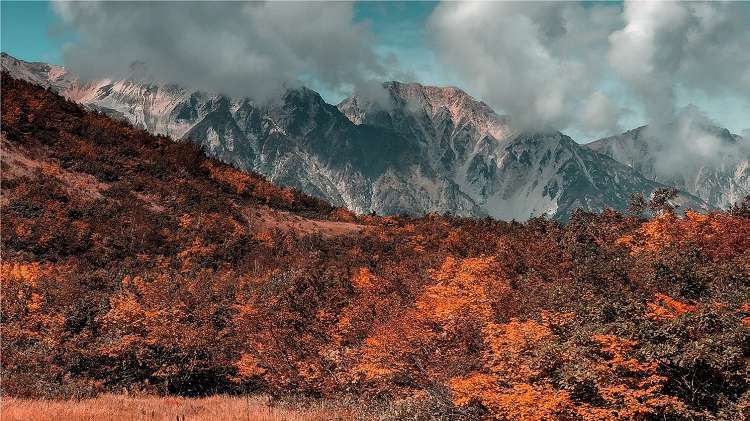
Koyasan, Wakayama prefecture, Kansai. Photo by Samuel Berner on Unsplash
Many destinations only attract seasonal travellers, but Japan offers an array of adventures across the country at any time of the year. In fact, while Japan’s commonly perceived ‘off-season’ periods will depend on which part of the country you’re travelling to (and what for) they can be some of the best times to visit, giving you the chance to uncover an entirely different side to its many enriched and varied regions.
Ditching the skis for summer hiking in Hokkaido, swapping the cherry blossom crowds for coastal getaways, and even onsen hopping during the autumn while soaking up glorious fall leaves are just some of the inspiring alternatives to Japan’s popular ‘peak’ season experiences.
What’s more, travelling when hotels and tours are generally quieter in certain regions could also help you enjoy a more budget-friendly getaway – all now with the added benefit of knowing you’re supporting local seasonal businesses after a few years of travel curbs.
Here’s the ultimate guide to experiencing the lesser-known treasures of Japan’s most popular destinations while avoiding their busiest, peak periods.
Kansai
Swap the crowds of sakura season and see the wintry side to this region that incorporates Hyogo, Kyoto, Nara, Osaka, Shiga and Wakayama prefectures.
Winter is perhaps one of the best times to visit Kansai to admire its most beautiful sites dusted with a light layer of snow. You might even choose to participate in one of the numerous festivals held to celebrate the winter.
And if you can’t afford to miss your Japanese flower fix, you can see the flowering of the ume (Japanese plum trees) as early as February in Kansai, with their intense pink flowers appearing in parks and temples all over the region.
Why not try: Yunohana-Onsen is a quiet onsen (hot spring) retreat with easy access from Kyoto in the city of Kameoka. With more than a dozen temples and shrines in the small area, the village is surrounded by sightseeing spots including Myoshoji-Temple, Mt Asahi, Jinzoji-Temple, Anaoji-Temple and Hiedanojinja-Shrine. http://yunohana-onsen.com/english
The most popular photographs of Kyoto's Daigoji Temple are taken during autumn when the site turns into a kaleidoscopic scene of ochre, orange and crimson. But it's during the winter, after the colour fades from the surrounding trees, that the bright red temple and adjacent bridge really get to shine. https://kyoto.travel/en/shrine_temple/178.html
Hokkaido
There is no shortage of snow in Hokkaido in the winter – perfect for its world-class ski slopes. But if you prefer warmer climes, Hokkaido is truly blissful in summer.
Hokkaido is the least populated of Japan's islands, making it a perfect fit for adventurers looking to hike or cycle, or spot some of the country's wildlife. Hokkaido's location as Japan's northernmost island works in its favour because it does not get as hot or humid as other areas of the country. Hokkaido has six national parks to explore in the milder temperatures, all boasting breathtaking natural scenery, usually hidden by snow, including colourful vegetation that you thought only existed in fairy tales.
With agriculture being one of its main economic pillars, exceptional food with the freshest produce is one of Hokkaido’s biggest attractions. Sea urchins, or uni, are a Hokkaido favourite. Those harvested from June to August – especially from Rishiri, Rebun, and Shakotan – are a seasonal must.
Why not try: The Shiretoko Peninsula on the island's easternmost portion, was registered as a UNESCO World Heritage Site in 2005 for its flora and fauna, and whale-watching is also popular. The nearby Daisetsuzan National Park is also a paradise for hikers. https://www.japan.travel/en/spot/2143/
Lavender fields at ‘Farm Tomita in Furano’ are filled with the purple plant as well as a number of colourful flowers. For the best experience, visit in July when they’re at their very peak (and don’t forget to try the lavender soft serve before you leave). https://www.farm-tomita.co.jp/en/

Flower fields of Hokkaido. Photo by Yuri Shirota on Unsplash
Okinawa
Being 400 miles south of mainland Japan puts Okinawa roughly on the same equatorial plane as Hawaii - and the similarities don’t end there – making for a perfect springtime escape.
With picturesque white-sand beaches, subtropical Okinawa is actually a group of more than 160 islands ringed by sapphire waters and lush landscapes. Getting there is an easy hop from Tokyo or Osaka, which is why the remote retreat is a favourite among locals to escape the everyday and relax into bliss.
Many of Okinawa’s most popular resort beaches are open for swimming from March, making it a perfect springtime destination before the summer crowds arrive. At this time of year, the days are generally hot, with comforting temperature dips in the evenings.
Seasonal events abound throughout Okinawa in spring, from energetic hari boat races to lilies in bloom on Ie Island and fireflies on Kume Island. The Okinawa Churaumi Aquarium, one of the world's largest, is a popular pitstop and has a unique whale shark breeding program.

Ishigaki Island, Okinawa. Photo by Vladimir Haltakov on Unsplash
Why not try: Futamigaura Beach on Izena Island is a 55-minute ferry from Okinawa Island and features blue sea scapes and panoramic vistas of Gusuku Mountain’s towering rock formations and Yanaha Island. https://visitokinawajapan.com/destinations/
On Irabu Island just southwest of the mainland is Iraph Sui, a Luxury Collection Hotel situated on an azure oceanfront parcel. Opened in 2018, the lavish beach retreat has suites with sea views, fine dining, and a full-service spa. https://www.marriott.com/en-us/hotels/okalc-iraph-sui-a-luxury-collection-hotel-miyako-okinawa
Nagano
Before the snow arrives in early winter, Nagano is one of the best spots in the country to enjoy all that the crisp months of autumn have to offer.
Autumn is one of the most beautiful times of the year in Nagano. The region’s highlands and mountainous areas are made for momiji-gari (autumn leaf viewing). The many ropeways designed for winter sports make it easy to see golden alpine scenery and hike around the Japanese Alps.
And who could forget the bounty of autumn harvest? Fresh apples and grapes are ready for the picking in idyllic orchards; fields of mature buckwheat become delicious, aromatic soba noodles; and chestnuts are baked into tantalising Japanese desserts.
Why not try: Hakuba Mountain Harbor sits high in Hakuba Valley. During autumn, coloured foliage begins to cascade down the mountains as snow crowns the mountaintops. At their peak, around mid to late October, you can see Hakuba’s famous three-tiered autumn scenery: white snow, red leaves, and green forest. https://lets-do-hakuba.com/en/green-season/hakuba-mountain-harbor/
Ancient trails and towns remain nestled in Nagano’s mountains, wholly untouched by the passage of time. The Nakasendo Trail connecting Tokyo and Kyoto, walked by travellers and merchants during the Edo period, is still shrouded in forest along with many of the towns that supported it. From early October to early November, colourful decorations, such as freshly harvested persimmon trees, are hung outside local inns and shops. https://www.japan.travel/en/au/story/walking-nakasendo-road-magome-tsumago/

Hakuba, Nagano. Photo by Marek Okon on Unsplash

For more information, please contact:
James Cooley | james@thelucidagency.com.au | +61 401 316 701



















































